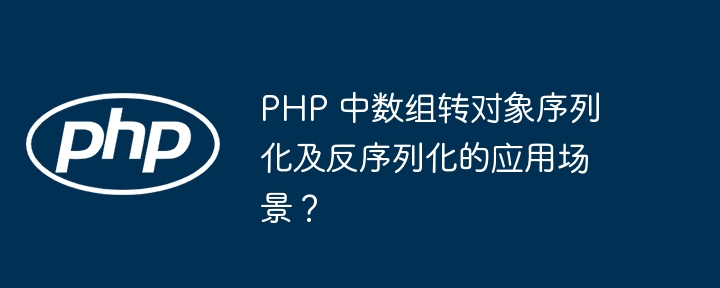 Backend Development
Backend Development
 PHP Tutorial
PHP Tutorial
 What are the application scenarios of array to object serialization and deserialization in PHP?
What are the application scenarios of array to object serialization and deserialization in PHP?
What are the application scenarios of array to object serialization and deserialization in PHP?
The application scenarios of PHP array to object serialization include data storage, transmission and caching. Deserialization is used for data retrieval, reception and modification. Specifically, serialization converts an array into a string containing the object's state, while deserialization restores that string to the actual object. Through serialization and deserialization, data can be stored, transferred, and modified efficiently, such as serializing an array into a string to store in a database, and then deserializing to reconstruct the array when retrieving it.

Application scenarios of array to object serialization and deserialization in PHP
Serialization and deserialization are the The process of converting data from one format to another. Array-to-object serialization involves converting a PHP array into a string containing the state of the object. Deserialization restores this string to an actual object.
Serialization application scenario:
- #Data storage: Serialize the array into a string for storage in a database or file system . Deserialize the string to reconstruct the array when you need to re-fetch the data.
- Data transmission: Serialize the array into a string for transmission over the network. The receiver deserializes the string to get the original array.
- Data cache: Serialize the array and store it in the cache to improve the speed of subsequent access to the same data. Deserialize the string in the cache to get the required array.
Deserialization application scenario:
- Data retrieval: Retrieve the serialized string from storage, and then reverse Serialize to get the original array.
- Data receiving: Receive the serialized string from the network and then deserialize to get the original array.
- Data modification: Deserialize the serialized string into an array, make modifications to the array, and then reserialize to update storage or transfer.
Practical case:
Consider the following example:
// 数组转对象序列化 $array = ['name' => 'John Doe', 'email' => 'john.doe@example.com']; $serialized = serialize($array); // 反序列化对象 $unserialized = unserialize($serialized); // 修改并重新序列化 $unserialized['email'] = 'jane.doe@example.com'; $newSerialized = serialize($unserialized);
In this case, the original array is serialized to a string and Stored in variable $serialized. The string is then deserialized back into an actual object, allowing its properties to be accessed and modified. The modified object is then reserialized into a new string $newSerialized for storage or transmission.
The above is the detailed content of What are the application scenarios of array to object serialization and deserialization in PHP?. For more information, please follow other related articles on the PHP Chinese website!

Hot AI Tools

Undresser.AI Undress
AI-powered app for creating realistic nude photos

AI Clothes Remover
Online AI tool for removing clothes from photos.

Undress AI Tool
Undress images for free

Clothoff.io
AI clothes remover

AI Hentai Generator
Generate AI Hentai for free.

Hot Article

Hot Tools

Notepad++7.3.1
Easy-to-use and free code editor

SublimeText3 Chinese version
Chinese version, very easy to use

Zend Studio 13.0.1
Powerful PHP integrated development environment

Dreamweaver CS6
Visual web development tools

SublimeText3 Mac version
God-level code editing software (SublimeText3)

Hot Topics
 PHP 8.4 Installation and Upgrade guide for Ubuntu and Debian
Dec 24, 2024 pm 04:42 PM
PHP 8.4 Installation and Upgrade guide for Ubuntu and Debian
Dec 24, 2024 pm 04:42 PM
PHP 8.4 brings several new features, security improvements, and performance improvements with healthy amounts of feature deprecations and removals. This guide explains how to install PHP 8.4 or upgrade to PHP 8.4 on Ubuntu, Debian, or their derivati
 CakePHP Date and Time
Sep 10, 2024 pm 05:27 PM
CakePHP Date and Time
Sep 10, 2024 pm 05:27 PM
To work with date and time in cakephp4, we are going to make use of the available FrozenTime class.
 CakePHP File upload
Sep 10, 2024 pm 05:27 PM
CakePHP File upload
Sep 10, 2024 pm 05:27 PM
To work on file upload we are going to use the form helper. Here, is an example for file upload.
 CakePHP Routing
Sep 10, 2024 pm 05:25 PM
CakePHP Routing
Sep 10, 2024 pm 05:25 PM
In this chapter, we are going to learn the following topics related to routing ?
 Discuss CakePHP
Sep 10, 2024 pm 05:28 PM
Discuss CakePHP
Sep 10, 2024 pm 05:28 PM
CakePHP is an open-source framework for PHP. It is intended to make developing, deploying and maintaining applications much easier. CakePHP is based on a MVC-like architecture that is both powerful and easy to grasp. Models, Views, and Controllers gu
 CakePHP Creating Validators
Sep 10, 2024 pm 05:26 PM
CakePHP Creating Validators
Sep 10, 2024 pm 05:26 PM
Validator can be created by adding the following two lines in the controller.
 How To Set Up Visual Studio Code (VS Code) for PHP Development
Dec 20, 2024 am 11:31 AM
How To Set Up Visual Studio Code (VS Code) for PHP Development
Dec 20, 2024 am 11:31 AM
Visual Studio Code, also known as VS Code, is a free source code editor — or integrated development environment (IDE) — available for all major operating systems. With a large collection of extensions for many programming languages, VS Code can be c
 CakePHP Logging
Sep 10, 2024 pm 05:26 PM
CakePHP Logging
Sep 10, 2024 pm 05:26 PM
Logging in CakePHP is a very easy task. You just have to use one function. You can log errors, exceptions, user activities, action taken by users, for any background process like cronjob. Logging data in CakePHP is easy. The log() function is provide





